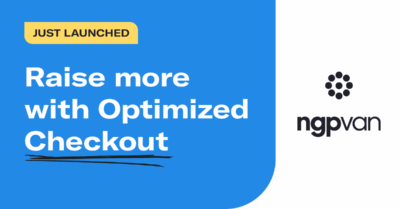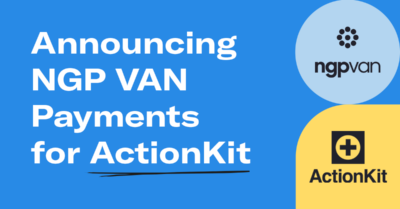Political campaign checklist: what to do before launch

Whether you’re a seasoned campaign manager or are new to the political sphere, planning a political campaign involves a lot of work and can feel overwhelming. You need to manage every step between registering your candidate, launching the campaign, and seeing it through to Election Day. To keep yourself organized and make sure you don’t miss anything, a political campaign checklist can help.
That’s why we’ve compiled this complete checklist for running for public office — to guide you through the process from start to finish and provide a foundational document you can refer back to throughout your campaign.
Sample checklist for running for public office
We’ve divided our political campaign checklist into 10 core sections that each include a variety of smaller tasks and activities. You can use our sample checklist as is, or tailor it to the specifics of your campaign, jurisdiction, and election level.
Start by checking off these 10 main action items, which we’ll describe in more detail below:
- Do your research.
- Build your campaign team.
- Clarify your platform, goals, and budget.
- Solidify campaign messaging.
- Plan voter outreach strategies.
- Create your fundraising plan.
- Gather campaign materials.
- Develop a social media strategy.
- Plan campaign events.
- Recruit and manage volunteers.
While you might not complete this entire checklist before you launch your campaign, you should at least have an idea of how and when you’ll approach each item on the list. Ultimately, following these steps will provide the foundation you need to run an effective political campaign, no matter what office your candidate is running for.
Step-by-step breakdown of our political campaign checklist
Dive deeper into the details of each political campaign checklist item to ensure you don’t miss any key steps of running for office.
Do your research.
Research is a crucial first step to ensure that your campaign is viable and your candidate has a good understanding of the race they’re entering. Before registering your candidate or hiring any campaign staff, research the following:
Election rules and timeline
Reach out to your relevant election authority to learn about election rules, campaign finance laws, advertising regulations, and any other laws that apply to your election. Note key dates as well, like registration deadlines and the early voting period for your race.
How to get on the ballot
What steps do you need to take to register your candidate? Does your candidate meet the age, residency, and citizenship requirements for running for their chosen office? When is the submission deadline? Is there a filing fee?
Just like election laws, the requirements for getting a candidate on the ballot vary by election level and jurisdiction and may even change from county to county. Check with your relevant election authority to answer these questions and find the specific forms you need to fill out. Some candidates need a certain number of petition signatures from voters before they can get on the ballot, so it’s important to research requirements early.
Voter sentiment
Research the voters in your district and learn about their concerns, voting histories, priorities, and demographics. Find information about partisan splits and popular issues by using polls, local news sources, and face-to-face conversations with community members.
The political landscape of your race
Learn more about the political landscape your candidate will enter by researching:
- The history of the office and who it’s been held by in recent election cycles
- Election history in your district, such as the voter turnout rate in recent years
- Opponents (both confirmed and potential) and their platforms
- The most important issues and talking points in the last race
- The success rate of campaigns similar to yours
This information will help you understand your candidate’s chances of winning and guide your campaign strategy. For example, if the office has been held by an incumbent for several years but the last election was a close race centering on the incumbent’s public health stances, you might make public health a key part of your campaign’s platform.
Plan voter outreach strategies.
Use the voter research you did earlier along with a voter file or database to determine who your target voters are. Based on data like voting histories and party affiliations, divide your target voters into two main categories, or universes:
- Your persuasion universe should include voters who are likely to vote but who you need to persuade to vote for your candidate. They may be swing voters or those who typically vote for the other party.
- Your mobilization universe should include the voters you feel confident will vote for your candidate. You need these voters to show up to the polls, so you’ll target them for mobilization during Get Out the Vote (GOTV).
Once you know who your target voters are and how you need to approach them, start creating the following outreach plans:
Field plan
Your field plan outlines all of your canvassing activities, how you’ll speak to voters about your candidate, and your plans for persuading and mobilizing target voters. This part of your political campaign checklist should include tasks like:
- Calculating and evaluating your vote goal
- Segmenting your audience into persuasion and mobilization targets
- Investing in any canvassing, voter management, and digital outreach tools you need
- Planning where and when you’ll go door-to-door canvassing
- Gathering lists of voters to contact during phone banking and text banking
- Finalizing scripts for volunteers to use while canvassing
- Determining how many volunteers you’ll need for canvassing
Schedule several dates or date ranges when canvassing will take place, and outline which dates you’ll focus on persuading voters and when your volunteers will canvass your mobilization targets for GOTV.
Communications plan
A campaign communications plan focuses on how you’ll communicate with voters online and in the media. Refer back to the campaign messaging you created, and use it to outline voter outreach content using:
- Text messages
- Your campaign website
- Online, print, or TV advertisements
- Press releases
- Direct mail
- Social media
Draft several different types of messages to voters that you can use throughout your campaign, such as introductions to your candidate, educational content, answers to FAQs, and appeals for support. Use one or more content calendars to plot out when you’ll send various messages using different channels.
Additionally, decide if you want to use ad targeting to get your message in front of specific groups of target voters.
Clarify your platform, goals, and budget.
Next, hone in on your candidate’s platform and policy positions. Why are they running for office? What issues are their top priorities? What makes them the right choice for this office right now? Clarify the major issues the campaign will focus on and how the candidate will approach them if elected. You’ll iron out the details of this platform more in the next step.
Then, zero in on the most important campaign goals. This includes your vote goal (the number of votes your candidate needs to win) and your fundraising goal (how much money you need to raise to fund the campaign).
Determining your vote goal
Your vote goal, also known as your win number, guides your field plan and communications strategy by telling you exactly how many voters you need to persuade and mobilize to vote for your campaign.
If you’re running in a two-person race, determine your win number using this formula:
- [estimated voter turnout percentage] x [number of registered voters] = number of expected votes
- ([number of expected votes] x .50) + 1 = win number
The past election data you researched earlier will give you an estimate of the voter turnout you can expect, while voter registration data tells you how many voters in your district are currently registered to vote. Using these numbers, you can easily calculate the simple majority you’d need to win a two-person race.
Setting your budget and fundraising goal
Your budget and fundraising goal are closely related, and you can use one of two methods for calculating them. You can either start by setting an achievable fundraising goal and base your budget on that number, or you can determine how much you need to spend on the campaign and set a goal to raise that amount.
Whether you start with projected expenses or how much you can realistically raise, keep in mind that your campaign budget will need to cover:
- Candidate registration fees
- Staff pay
- Marketing materials like signs, mailers, and flyers
- Advertising costs
- Events
- Software like canvassing apps or a political CRM
Include any resources you already have in your budget considerations, too, such as an office space your team can use throughout the campaign.
Create your fundraising plan.
Work with your campaign’s finance director or campaign manager to develop a plan to meet the fundraising goal you set earlier. Set smaller goals and choose metrics to measure your progress toward them. For instance, you might set a goal to call 100 potential donors by a certain date and keep track of the number of calls made by volunteers.
To reach your goals, choose multiple fundraising ideas and strategies for finding campaign donors. Use a fundraising database like NGP to identify, research, and prioritize donor prospects, then plan activities like:
- Call time fundraising, where volunteers use call lists and scripts to have conversations with potential supporters about donating
- Fundraising events that provide space to get to know donors and discuss your campaign in person
- Online advertisements that target potential donors and emphasize the impact donations will make on your campaign’s success
- Email and direct mail outreach in which you tell your candidate’s story and include links to your online donation page
Remember to follow all campaign fundraising and finance laws as you use your chosen strategies. If you’re unsure which rules apply to your campaign, check with your relevant election authority.
Build your campaign team.
Once you understand the landscape and know that your candidate can get on the ballot successfully, start forming your campaign team.
Depending on the size and resource availability of your campaign, you might hire a full staff or rely solely on dedicated volunteers. Either way, determine what roles you need to fill and how many people it will take to run the campaign. You may need to fill roles like:
- Campaign manager: The person who will take the lead on strategy development, overseeing staff, and communicating with the candidate
- Communications director: A staff member or volunteer in charge of campaign outreach, including advertising, email outreach, and social media
- Finance director: Leader who manages campaign spending and fundraising
- Treasurer: A financial expert who manages bookkeeping and financial reporting, ensuring that the campaign follows all relevant campaign finance laws
- Field director: The person in charge of canvassing and voter outreach who directs field organizers and volunteers
- Volunteer coordinator: A staff member who recruits, schedules, and manages campaign volunteers
You may not need all of these roles filled if you’re running a small volunteer-based campaign. However, larger campaigns may need a paid staff member for each one in addition to more specialized positions like a policy advisor or political consultant. Evaluate your needs, resources, and initial team members’ experience levels to determine if you need to expand your campaign team further.
Solidify campaign messaging.
Hone your candidate’s platform further by creating a consistent, compelling message for the campaign. Use this campaign messaging checklist to outline the details:
- Develop a succinct message the candidate can repeat and expand on as needed
- Write out key campaign talking points
- Choose a memorable slogan for the campaign
- Create written statements about each of the candidate’s policy positions
- Plan how the campaign will speak about opponents
- Draft a script for volunteers to use when speaking to voters about the campaign
At this stage, you should also think about the communication tools and strategies you’ll use to distribute this message and take additional steps to prepare.
For instance, will your candidate participate in live debates? Schedule time to practice their talking points and answers to potential questions. Will you run a CTV ad or a display advertisement that attacks the opponent? Determine what kind of language you’ll use and test it with potential supporters to see how they react.
Design your website and campaign materials.
To put your plans into action, you’ll need a variety of professional materials that represent your campaign and communicate your candidate’s message well.
The most important resource you need is a campaign website. Your website will act as a hub for all of your other materials, including your donation page, volunteer registration forms, and information about your candidate’s platform. Use an intuitive content management system (CMS) to design a website that’s easy to navigate and tells your campaign’s story using compelling text and visuals.
Besides your website, a typical political campaign checklist of materials you need includes:
- Yard signs
- Flyers and brochures
- Direct mail appeals
- Social media profiles for your candidate
- Buttons and stickers
- Additional branded merchandise for larger campaigns, like t-shirts or hats
Make sure that your branding stays consistent across all of these materials. Your campaign should have a recognizable logo, slogan, and a few colors associated with it. Branding consistency will help voters, donors, and other supporters easily recognize and trust your campaign materials.
Develop a social media strategy.
While social media should play a major role in your overall communications strategy, you should also develop a dedicated strategy for your campaign’s approach to social media. Which platforms will you use? Will you create paid ads along with content for your profiles? How will you create cohesive content across platforms?
Your social strategy might include some or all of the following platforms:
- Facebook: Facebook is still the most-used social media platform, and it has robust ad targeting capabilities you can use to get your advertisements in front of the right audience.
- Instagram: Plan to post visual content like photos, videos, and infographics on Instagram, and use the Stories function to interact with supporters.
- X (formerly Twitter): Use X to make short announcements, comment on current events, and respond to other political figures publicly.
- TikTok: Access younger voters by making short-form videos and taking advantage of trending sounds on TikTok.
Use a content calendar to plan posts across different social media platforms and keep your profiles cohesive. In your calendar, note which platform each post should go on, what date and time to publish it, which visuals or links it needs to include, and who to tag, if anyone.
Plan campaign events.
If you plan to host any fundraising events or general campaign events like a launch party, consider what resources you’ll need and when you might schedule them. Brainstorm ideas for events you might host, then think about:
- Your budget for events
- Venue space for in-person events
- Catering if you’ll have food
- Event marketing plans
- How to collect donations at events
- Volunteers needed
- Guest speakers or community leaders to invite
Events can get expensive, especially large-scale gatherings like galas. Consider smaller in-person gatherings or even virtual events that can still be effective options without breaking your budget.
Recruit volunteers.
Finally, plan your approach to volunteer recruitment and management. Most campaigns require many volunteers to reach enough voters to win, so you should start recruiting early.
Take the following steps to recruit the volunteers you need to sustain your political campaign:
- Determine which activities you need volunteers for, such as canvassing, phone banking, and fundraising call time
- Define the responsibilities and time commitment for each event and role
- Create volunteer information and registration pages on your website
- Promote your volunteer opportunities on social media
- Send recruitment emails and text messages to supporters on your contact list
Be sure to screen the volunteers who sign up and provide them with all of the training and resources they need to represent your campaign. This includes canvassing scripts, call lists, canvassing apps, guidebooks, and your team’s contact information.
Maximizing your political campaign checklist
Using our political campaign checklist can get your team started on the right foot, but it takes more than good planning to win an election. You’ll need to pivot your campaign plans as new factors come into play and use all the resources at your disposal. NGP VAN’s leading campaign tools for Democratic and progressive candidates can make accomplishing this checklist easier, helping you reach more voters, raise more funds, and pave the way to victory.



